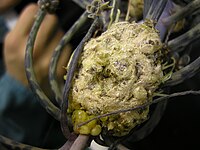
Photo from wikipedia
Abstract Specialized herbivorous insects have the ability to transition between host plant taxa, and considering the co-evolutionary history between plants and the organisms utilizing them is important to understanding plant… Click to show full abstract
Abstract Specialized herbivorous insects have the ability to transition between host plant taxa, and considering the co-evolutionary history between plants and the organisms utilizing them is important to understanding plant insect interactions. We investigated the role of a pine tree parasite, dwarf mistletoe (Arceuthobium spp.) M. Bieb. Santalales: Viscaceae, in mediating interactions between Neophasia (Lepidoptera: Pieridae) butterflies and pine trees, the butterflies' larval hosts. Mistletoe is considered the butterflies' ancestral host, and the evolutionary transition to pine may have occurred recently. In Arizona, United States, we studied six sites in pine forest habitats: three in Neophasia menapia (Felder and R. Felder, 1859) habitat and three in Neophasia terlooii Behr, 1869 habitat. Each site contained six stands of trees that varied in mistletoe infection severity. Butterfly behavior was observed and ranked at each stand. Volatile compounds were collected from trees at each site and analyzed using gas chromatography-mass spectroscopy. Female butterflies landed on or patrolled around pine trees (i.e., interacted) more than males, and N. terlooii interacted more with pine trees than N. menapia. Both butterfly species interacted more with tree stands harboring greater mistletoe infection, and N. terlooii interacted more with heavily infected tree stands than did N. menapia. The influence of mistletoe on Neophasia behavior may be mediated by differences in tree volatiles resulting from mistletoe infection. Volatile profiles significantly differed between infected and uninfected pine trees. The role of mistletoe in mediating butterfly interactions with pines has implications for conservation biology and forest management, and highlights the importance of understanding an organism's niche in an evolutionary context.
Journal Title: Environmental Entomology
Year Published: 2018
Link to full text (if available)
Share on Social Media: Sign Up to like & get
recommendations!